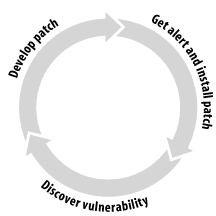1.1 The Vulnerability Cycle
Let's consider for a moment an all-too-common sequence of events in today's security world. (Figure 1-2 illustrates it graphically.)
Someone uncovers and discloses a new vulnerability in a piece of software.
Bad guys quickly analyze the information and use the vulnerability to launch attacks against systems or networks.
Simultaneously, good guys (we'll include security folks who work for the vendor) start looking for a fix. They rally software development engineers in their respective organizations to analyze the vulnerability, develop a fix, test the fix in a controlled environment, and release the fix to the community of users who rely on the software.
If the vulnerability is serious, or the attacks are dramatic, the various media make sure that the public knows that a new battle is underway. The software developers at the organization that produced the product (and the vulnerability!) are deluged with phone calls from the media, wanting to find out what is going on.
Lots of folks get very worried. Pundits, cranks, finger-pointers, and copycats do their thing.
If a knee-jerk countermeasure is available and might do some good, we'll see a lot of it. (For example, CIOs may direct that all email coming into an enterprise be shut off.) More often than not, this type of countermeasure results in numerous and costly business interruptions at companies that rely on the software for conducting their business operations.
When a patch is ready, technically oriented folks who pay close attention to such matters obtain, test, and apply the patch. Everyday system administrators and ordinary business folks may get the word and follow through as well. Perhaps, for a lucky few, the patch will be installed as part of an automated update feature. But inevitably, many affected systems and networks will never be patched during the lifetime of the vulnerability?or will only receive the patch as part of a major version upgrade.
Security technicians, their attention focused, examine related utilities and code fragments (as well as the new patch itself!) for similar vulnerabilities. At this point, the cycle can repeat.
Weeks or months go by, and a piece of malicious software is released on the Internet. This software automates the exploitation of the vulnerability on unpatched systems, spreading without control across a large number of sites. Although many sites have patched their systems, many have not, and the resulting panic once again causes a great deal of business interruption across the Internet.
Figure 1-2. The vulnerability/patch/alarm cycle

What's so bad about this scenario? Let's consider some of the effects.
Many companies (some big, some small) just can't keep up with today's cascade of patches. To get a sense of the scope of the problem, let's assume that the Internet and its critical services run on 100 key applications. We estimate (conservatively, in our opinions) that there are 100 or so vulnerabilities per application system. If that guess is in the ballpark, that's about 10,000 security holes for hackers to exploit, just in key applications!
Here's a rough calculation relating to operating systems. Noted "secure coder" Wietse Venema estimates that there is roughly one security bug per 1000 lines in his source code. Given that desktop operating systems such as Linux or Windows represent some 100 million lines of code, this translates into hundreds of thousands of potential security bugs. According to CERT statistics, collectively we will probably discover roughly 5000 bugs in 2003. At this rate it could take 20 years per operating system to find all the security bugs. Fixing them will take a little longer; our experience is that, using today's common practices, 10% to 15% of all security patches themselves introduce security vulnerabilities! (It is only fair to point out here that these numbers are anything but scientific, but we believe they're not far from correct and the underlying point remains the same.)
Applying patches over and over?as though system administrators had nothing else to do?is never going to give us a secure Internet-based infrastructure. As society's reliance on Internet services grows, it's only a matter of time before catastrophe strikes. The software so many of us depend on every day is frighteningly open to attack.






